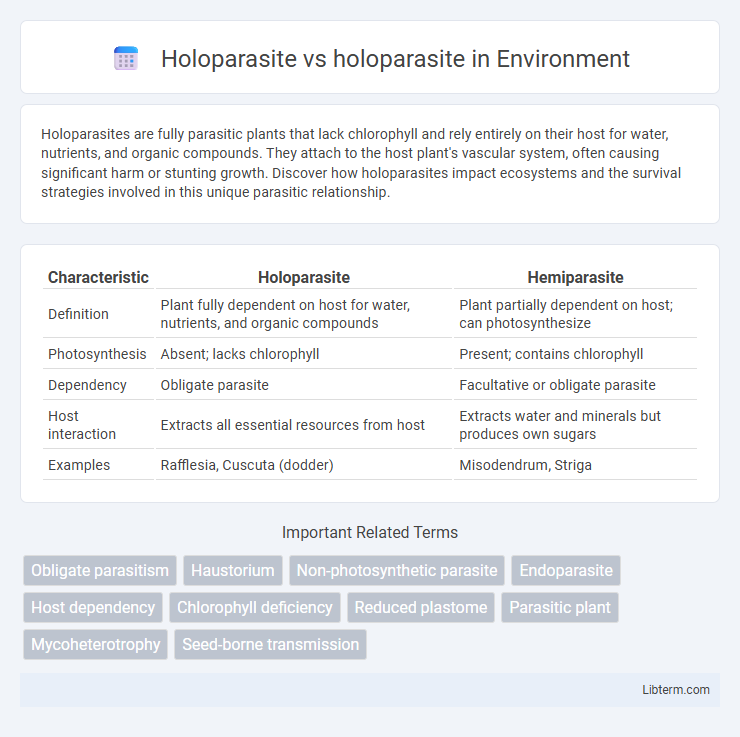Holoparasites are fully parasitic plants that lack chlorophyll and rely entirely on their host for water, nutrients, and organic compounds. They attach to the host plant's vascular system, often causing significant harm or stunting growth. Discover how holoparasites impact ecosystems and the survival strategies involved in this unique parasitic relationship.
Table of Comparison
| Characteristic | Holoparasite | Hemiparasite |
|---|---|---|
| Definition | Plant fully dependent on host for water, nutrients, and organic compounds | Plant partially dependent on host; can photosynthesize |
| Photosynthesis | Absent; lacks chlorophyll | Present; contains chlorophyll |
| Dependency | Obligate parasite | Facultative or obligate parasite |
| Host interaction | Extracts all essential resources from host | Extracts water and minerals but produces own sugars |
| Examples | Rafflesia, Cuscuta (dodder) | Misodendrum, Striga |
Introduction to Holoparasites
Holoparasites are fully parasitic plants that lack chlorophyll and depend entirely on their host plants for water, nutrients, and organic compounds. These organisms establish haustorial connections to extract resources directly from the vascular system of their hosts, often causing significant physiological stress. Key examples include species from the genera Rafflesia and Balanophora, which display unique adaptations for a non-photosynthetic lifestyle.
Defining Holoparasites: Key Characteristics
Holoparasites are obligate plant parasites that lack chlorophyll and rely entirely on their host plants for water, nutrients, and organic compounds, distinguishing them from hemiparasites which retain some photosynthetic capability. Key characteristics include the absence of functional leaves or reduced leaves, specialized haustoria that penetrate host tissue to extract resources, and a complete dependency for survival and reproduction. Examples of holoparasitic plants include species like *Rafflesia* and *Orobanche*, which exhibit these defining traits in their parasitic strategies.
Types of Holoparasites in Nature
Holoparasites are completely dependent on their host plants for water, nutrients, and photosynthates due to their lack of chlorophyll, with common types including broomrape (Orobanche spp.) and dodder (Cuscuta spp.). These obligate parasites exhibit diverse host specificity, ranging from generalists that infest multiple plant families to specialists targeting particular genera. Ecological roles of holoparasites significantly influence plant community dynamics, as they can regulate host population and promote biodiversity by suppressing dominant species.
Lifecycle and Reproductive Strategies
Holoparasites exhibit a unique lifecycle by completely relying on their host plants for water, nutrients, and photosynthesis, surviving without chlorophyll and often producing haustoria that penetrate host tissue to extract resources. Their reproductive strategy typically involves producing numerous seeds with mechanisms for effective dispersal to locate new host plants, often synchronized with the host's growth cycle to optimize establishment. Holoparasites contrast with hemiparasites, which retain some photosynthetic ability and exhibit more flexible reproductive tactics, while holoparasites remain obligate parasites throughout their lifecycle.
Host Specificity and Adaptations
Holoparasites exhibit strict host specificity, relying entirely on particular host plants for water, nutrients, and photosynthesis substitutes, often targeting a narrow range of species. Their morphological adaptations include the loss of chlorophyll and leaves, with highly specialized haustoria that penetrate host tissues to extract resources efficiently. In contrast, hemiparasites retain some photosynthetic ability and show broader host compatibility, reflecting less dependency and different adaptive traits focused on partial parasitism.
Physiological Mechanisms of Parasitism
Holoparasites rely entirely on their host plants for water, nutrients, and photosynthates due to the complete loss of their photosynthetic machinery, employing specialized haustoria to penetrate host vascular tissues. These haustorial organs facilitate the direct extraction of xylem and phloem contents, ensuring an efficient translocation of essential metabolites and signaling molecules that support parasite growth and development. In contrast, hemiparasites retain partial photosynthetic capacity, allowing a dual energy acquisition strategy, but holoparasites exhibit a fully dependent physiological mechanism that bypasses autotrophic metabolism.
Ecological Roles of Holoparasites
Holoparasites, entirely dependent on their host plants for nutrients, play a significant ecological role by influencing plant community dynamics and biodiversity. These obligate parasites, such as species in the genera *Orobanche* and *Rafflesia*, often regulate host populations and create niche opportunities for other organisms. Their presence can alter nutrient cycling and energy flow within ecosystems, highlighting their integral function in maintaining ecological balance.
Holoparasite vs. Hemiparasite: Key Differences
Holoparasites are fully parasitic plants that lack chlorophyll and rely entirely on their host for water, nutrients, and energy, while hemiparasites retain chlorophyll and can perform photosynthesis to some extent. Holoparasites connect to the host's vascular system to extract all necessary resources, whereas hemiparasites partially depend on the host but supplement their nutrition through photosynthesis. Key examples of holoparasites include genus *Rafflesia*, while hemiparasites are commonly found in the family *Orobanchaceae*, such as *Striga* species.
Impact of Holoparasites on Host Plants
Holoparasites, such as Cuscuta and Orobanche species, completely depend on their host plants for water, nutrients, and organic compounds, often leading to significant reductions in host biomass and reproductive success. These parasitic plants attach to the host's vascular system, disrupting nutrient flow and causing physiological stress that can result in weakened growth or even death of the host. The impact of holoparasites on agricultural crops and natural ecosystems includes decreased crop yields, altered plant community dynamics, and increased vulnerability to environmental stresses.
Future Research and Conservation Concerns
Holoparasites, entirely reliant on host plants for nutrients, present unique challenges for conservation due to their strict host specificity and vulnerability to habitat loss. Future research should prioritize genomic studies to unravel their complex parasitic mechanisms and develop targeted strategies for preserving both holoparasites and their host species. Understanding holoparasite ecology is critical for maintaining biodiversity and ecosystem stability in affected habitats.
Holoparasite Infographic

 libterm.com
libterm.com